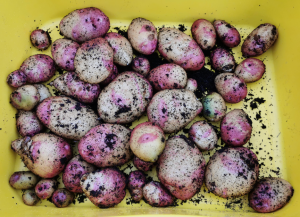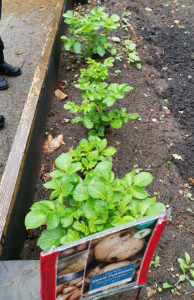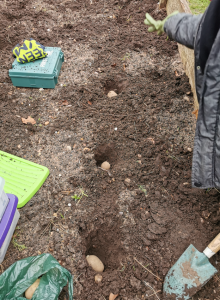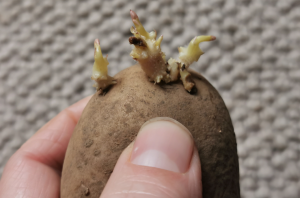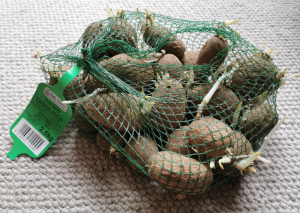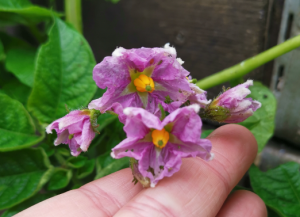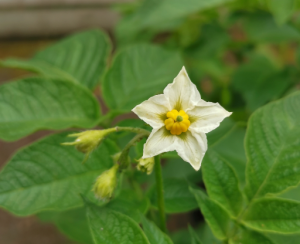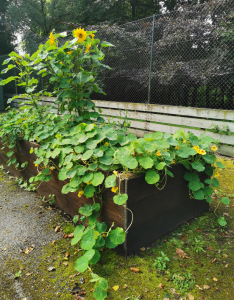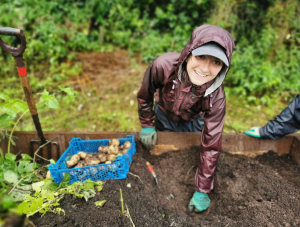
What Are Potatoes?
Great. They are just great.
Potatoes are a root crop, known as tubers. They are swellings of roots, and one seed potato can produce ten more. Potatoes are most commonly grown from seed potatoes, which are small baby spuds. Potatoes do flower and produce a fruit, but these are not used to grow new potatoes – these fruits are inedible due to being poisonous.
Potatoes are related to tomatoes and aubergines, as well as deadly nightshade. Never eat a potato with green skin! Always store potatoes in a dark place so that they don’t turn green.
For the LOTR fans among us, we know that potatoes can be boiled, mashed, or stuck in a stew. But you can also roast them, bake them, microwave them, slice and dice them, tater tot them, hash brown them, make tatty scones, chunky chips, thin chips, crinkly chips, potato waffles… Potatoes are brilliantly useful in the kitchen, and can be stored for AGES in the right conditions (cool, dark, ventilated).
Which Ones to Grow?
There are so many different types of potatoes, and they are often split into First Early, Second Early, and Maincrop. I am the worst person to talk about these as my method of gardening is as follows: Chuck it in the ground, see if it grows.
Kay at TCV National Forest has done a video about chitting potatoes which you can see here [clicky], but again, I never chit my spuds – not purposely anyway. I tend to forget about them in the shed and when I find them again, there are potato tentacles emerging out of the bag! Kay has also discussed the types of potatoes and the benefits of each.
You can find purple, red, or pink varieties. Some have purple skin and white flesh, some are purple all the way through, which makes for interesting mash. Last year at Selly Oak Green Gym we grew a variety with pink and white blotched skin.
How Many to Grow?
If you want continuous cropping, this is where you need to pay attention to first and second earlies, and main crop. Main crop spuds can then be stored over winter giving you a source of food. They can also be left in the ground over winter with a good layer of straw or hay to keep the ground slightly warmer. If your soil is waterlogged and heavy (think Birmingham clay) then don’t leave them in the ground as they will rot.
One or two potato plants will be enough for the family. I am going to plant four seed potatoes at home (two of each variety I have) which should yield 30-40 spuds at the end of summer.
Where to Grow Spuds
This article was written pre-lockdown, – we have now missed the boat for growing potatoes this year – seed potatoes are available to buy from winter onwards, and are best chitted in Feburary/March, and then planted according to which variety they are. Potatoes are a summer crop but can be stored and kept over winter.
Anywhere with deep enough space for the roots to grow and swell. You can use:
- Raised beds
- Large plant pots
- Plastic recycling bins
- Old compost bins
- Active compost heaps (seriously – the best spuds are grown on compost heaps)
- Potato planting bags
- Grow bags
- Shopping bags – the big heavy duty ones. I have known people to grow potatoes in Ikea bags before!
I am using raised beds for mine. I cannot grow directly into the ground on my allotment as it floods so I have to grow well above the water table.
Growing Tatties
Lots of people grow potatoes using the layering method of layering – there are lots of ideas on Pinterest. Basically, you put some compost in a pot/bag/tub, and put a couple of seed potatoes in. When they have grown up to 30cm, you then backfill with fresh compost and cover the leaves so only 5cm is showing. In this fresh compost the potato plant stems will send out new roots onto which new potatoes will grow. Wait for the leaves to grow to 30cm, and do it again.
When you harvest the potatoes the biggest ones will be at the bottom so you harvest bottom up.
At Ley Hill Green Gym we have simply bodged holes into the soil level of the raised beds and placed one seed potato per hole. They are about 30cm apart, and rows are 60cm apart. We have not done peaks and troughs of soil, however, when the spuds grow we will be backfilling this bed with fresh compost.
Lots of people grow potatoes in ridge & furrow systems – that is, peaks and troughs. You dig a trough, heap the soil to the side in a peak and space the seed potatoes evenly along the trough. Cover them with some soil, and then as the potatoes grow, use the soil from the peak to bury the leaves. This encourages more potatoes to grow from side roots from the plant stems.
Potatoes will flower, so they need to be grown outdoors, but they do not need pollinating to get potatoes.
You don’t necessarily need to wait for the potatoes to chit, or for the eyes to grow, but it does encourage them to grow if they have grown a bit before being planted.
Plant Spacing
30cm between seed potatoes, 60cm (2ft) between rows.
If you are using plant pots, recycling boxes, put max. three seed potatoes for a 45cm pot.
For shopping bags you can probably fit six seed potatoes.
Crop Rotation
Do not grow potatoes in the same place year after year. This causes a build up of bacteria which can cause potato blight.
Potatoes typically follow brassicas, but if this is your first time growing potatoes, just go for it!
Companion Planting
Don’t plant spuds near tomatoes or aubergine as they are part of the same family and can spread blight between them.
You can plant salad crops between rows of potatoes, but the leaf growth from potatoes will rapidly cover any salad crops! For some colour, try calendula, tagetes (French marigolds), and nasturtium.
Harvesting Your Pomme de Terres
Leave them in the ground to get larger, or harvest them earlier for new potatoes. Do a bit of exploratory digging with your fingers (gently!) to investigate the sizes of the potatoes. If you want them bigger, cover them back over and leave them.
When harvesting, use a small garden hand fork and gently dig – on more than one occasion I have speared potatoes using a large full-size garden fork! Turn the ground and get as many potatoes as possible. If you find small, marble size root swellings try and remove these too – these will grow into potatoes next year if you don’t remove them! Riddle (sieve) the soil to find more potatoes. It doesn’t matter how well you dig, there will always be more. Just ask the Woodgate Valley Green Gym volunteers and they’ll confirm.
Potatoes are ready for harvest when the leaves have yellowed and wilted, or died back completely.
Hints and Tips
If you have any questions, Laura is happy to answer them via email, Facebook or Twitter
- Email: Laura.Hamilton@TCV.org.uk
- Facebook: Health For Life in the Community
- Twitter: TCV_Birmingham
Remember to share your pictures with us on Facebook and Twitter too!
If you know of any other potato names, please also email these to Laura as it will amuse her greatly 😊

